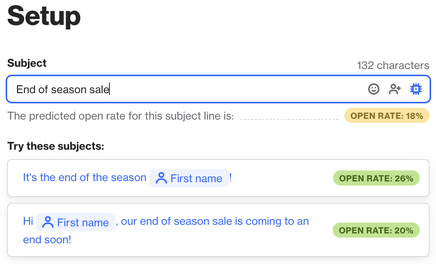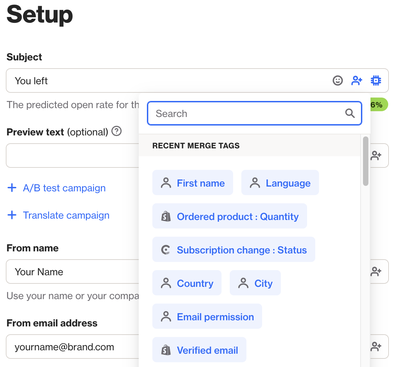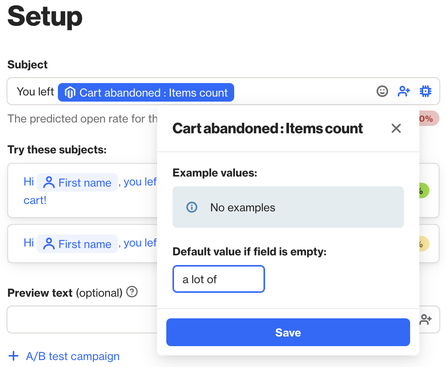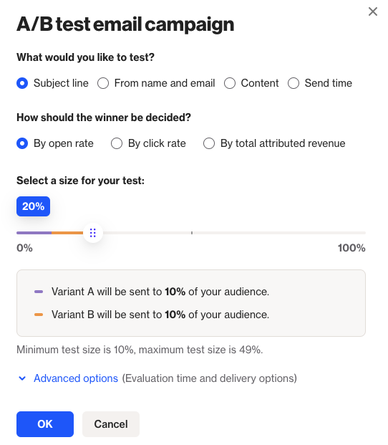Email campaign setup
Overview
The Setup tab of an email campaign allows customers to configure key aspects of their email campaigns, such as subject lines, A/B testing, sender email and name, and marking emails as transactional. It also includes options for open rate optimization, tracking, and delivery load distribution.
Accessing campaign setup
Navigate to Marketing > Campaigns, select the relevant campaign, click Edit, and then select Setup.
Setup options
Subject line
Enter a subject line for your email:

AI subject line open predictor
Ortto AI will estimate the open rate and suggest better options. If you like a suggestion, click on it to update your subject line. To turn off suggestions, just click the AI button.
- AI suggestions will only appear if your subject line contains at least 10 characters.
- AI suggestions support all languages.
- You’ll only see suggestions when the predicted open rate is higher than your current subject line.
- Predictions are dynamic, results may vary over time as the model evolves and learns from new data.
You can also add merge tags to the subject line:
- Click the merge tag icon to insert tags wherever you see it.
- Choose a recent merge tag or select a field or activity attribute to add.

When you select a field or attribute, you'll see example values and can set a default value if the original value is empty.

Preview text
Set the preview text—this step is optional but recommended. It’s the text recipients will see in their email client, which can encourage them to open the email along with the subject line.

A/B Testing
You can A/B test your campaign by trying different subject lines, preview text, sender names, and content.
NOTE: You can combine the A/B test with the Translate campaign. If you select both features, you'll need to create translated subject lines or content based on your A/B test setup.

Translate campaign: This option is available only if you’ve selected a language under Settings > General > Language > Translations.
When selected, the email subject and content will be translated into the chosen languages for recipients who prefer them. Email translation uses display conditions (Liquid syntax) in the Content step.
Learn more about language settings.
Learn more about how to display translated email message content.
NOTE: You can combine the Translate campaign with Open Rate Optimization (both can be selected). If you choose both features, you'll need to create a second subject line in the selected languages.
Sender email and name
Enter a from name: This is the name of the person sending the campaign. We recommend using a real person's name from your business to make the email feel more personal. You can use merge tags like Owner name to customize the From name for each recipient.
Enter a from email address: This is the email address the campaign will be sent from and where replies will go by default. You can also specify a different reply-to address. Merge tags, such as Owner email address, can be used here to personalize the email for each recipient.
Transactional email
Select this option and provide a purpose if your email is transactional.
IMPORTANT:
- Transactional email is only support on selected Ortto plans.
- Only mark a message as transactional if it is genuinely transactional in nature.
Learn more about making campaign messages transactional.
CC/ BCC
You can add multiple recipients to CC or BCC by separating their email addresses with commas.
IMPORTANT: If you have configured CC or BCC recipients in your email, please be aware that using the Send test email action will also send the test email to those recipients.
NOTE: When using a button to send an email upon being clicked, it is not possible to add a CC or BCC recipient.
Reply-to email
Use this field to specify a different address for replies. This is helpful if you want responses to go to another inbox.
- If you only specify a from address: That address will serve as both the sender and the reply recipient. Clicking eply will send responses to the from address.
- If you specify both a from and a reply-to address: The from address is used to send the email, while replies will be directed solely to the reply-to address.
Advanced options
Delivery load distribution
You can rate limit email delivery, extending your send time by up to 30 days. This helps manage expected responses, such as increased website or call center demand after an event announcement.
Learn more about delivery load distribution.
Open rate optimization
Check this box if you want to automatically resend the email later (after 24 hours, 2 days, 3 days, or 7 days) with a different subject line if it remains unopened. If you don’t select this feature, you can manually resend the email after 24 hours (within 30 days of the original send date).
NOTE: Before resending after the selected timeframe, we re-check recipients against the original filter. This includes individuals who:
- Did not open the original email.
- Received an invalid email due to prevention limits.
- Only those who match the re-checked filter will be included in the new send.

NOTE: To protect your deliverability and reputation, contacts who bounced in the original send will automatically be excluded from the automatic resend.
IMPORTANT: Resending a campaign may increase your chances of unsubscribes and complaints, so use this feature wisely.
- Learn more about resending an email.
- Learn more about complaints, sender reputation, and email deliverability.
Tracking
Choose to track email opens, link clicks, and/or automatically add UTM parameters and hashed email addresses to links in your email.
- UTM parameters: These help track website traffic by adding campaign information to each URL. If enabled, UTM parameters will automatically be included in all links in the email campaign.
- Learn more about UTM tracking.
- Hashed email addresses: This feature adds a SHA-256 hash of the recipient's email address to any clicked links. When a recipient clicks a link, the URL will include a
user_emailparameter with the hashed code, allowing you to link clicks to specific users using your analytics tools.EX: user_email=8b1a9315f94318b994b7b9262295ae43fe089424c0c86a0ebe5e5bb76c00f127
NOTE: You must select Track link clicks to enable the addition of UTM and email hash parameters.
Reactions
Reactions are enabled by default in your email campaigns. They show 5 emojis in the footer, letting recipients share their thoughts easily. This feature helps gather feedback and understand sentiment, which can reduce unsubscribe rates.
Learn more about email reactions.
Dynamic content
Dynamic content allows you to pull information from a JSON endpoint you manage. You can choose to use the same content for all emails or customize content for individual contacts in groups of 200.
Learn more about how to use a JSON endpoint for dynamic email content.
Attribution
Each email campaign uses your default attribution settings. However, if you're sending emails about event registrations, tracking orders may not apply. In this case, you can set a custom activity for reporting instead.
Learn more about attribution.
